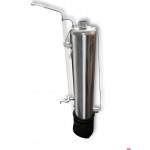
Stages of Household Autoclave Production
The production of a household autoclave is a labor-intensive process that takes quite a bit of time. As a buyer, you might want to know how autoclaves are made and what semi-finished products they consist of.
1. Elliptical Bottom
The first and most important part of a household autoclave is the elliptical bottom. It is crucial that all components working under pressure have a cylindrical shape without any straight angles. No flat surfaces, only rounded spherical forms. Otherwise, the tank will not withstand even minimal pressure and may bulge. We will write a separate article on the importance of elliptical bottoms.
Such bottoms are produced using stamping or rotational drawing methods. We use the latter. A metal sheet is cut to a size of 400 by 400 mm. It is then trimmed to form a circle, which is processed under pressure with a roller in a special rotational drawing machine. This way, we get an elliptical bottom. For the autoclave, we need two of these, for the top and bottom.

2. Autoclave Body
The second important part of the household autoclave is the body itself. In its semi-finished form, it is called the "shell." Manufacturing this part of the tank requires significant effort as well. First, we take a marked stainless steel sheet and send it to a guillotine (a metal cutting machine). By trimming all sides, we obtain a rectangular piece of metal that needs to be rolled on a "Sheet Metal Rolling Machine." Only after this does the sheet take the shape of a cylinder, and the work is considered complete for this segment.
3. Flange and Lid of the Autoclave
The third part of the autoclave is the flange and lid set. These components use thicker metal, approximately 6-8 mm. These parts are entirely made on a lathe. They are responsible for sealing the top part of the tank. A special rubber seal is installed between the flange and the lid. To ensure it fits tightly in both the lid and the flange, special grooves are turned. The rubber will fit into these grooves during tightening, providing complete sealing. Additionally, holes for all components (4 pcs.) and bolts (6 pcs.) are drilled in this set.

4. Other Parts
In addition to these main semi-finished products, many small parts are used to assemble a household autoclave:
- Flange for the heating element (threading is cut into stainless steel pipe on a lathe)
- Outlets for components on the lid (threads of type 1/2", 3/4" are also cut from pipe)
- Cutting stainless steel bolts that will later fasten the lid to the flange
- Supports for jars inside the tank (two semicircles are cut out, and legs are added)
- Heat-resistant rubber with bolt holes
- Cutting handles and giving them the correct shape

5. Argon Welding of Parts
Now that all the parts are made and ready, we proceed to welding. This is the most important and responsible stage in the production of the autoclave.
Welding in an argon gas environment. We use argon welding with stainless steel filler. All parts are assembled and welded. The bottoms are welded to the shell. The flange is welded on top with bolts. The lid is welded with all the necessary outlets for components of the household autoclave. Handles, legs, and covers for protecting the heating element contacts are also welded on.
Once welding is complete, the autoclave undergoes its first crucial pressure test. All openings are sealed, and a compressor is used to pressurize the tank to over 3 atm. This tests the quality and sealing of all applied welds (from our statistics, about 1 in 50 tanks fail at this stage and goes for rework).
6. Stainless Steel Treatment and Autoclave Assembly
The next stage is the treatment of the stainless steel to give the tank an aesthetic appearance. Specifically, this involves grinding and polishing all surfaces, especially the welding areas and weld seams. This final stage takes a lot of time and effort. Various types of grinding machines with attachments and pastes from leading manufacturers are used to give the stainless steel a glossy finish. In the end, we achieve a mirror-like appearance.
The last step for the autoclave is assembly. The heating element, pressure gauge, safety valve, and nipple are all sealed with sealing tape and screwed into their designated places.
Now the autoclave undergoes a second stage of testing. This time it is brought up to the maximum pressure of 6 atm. The functionality of all components, as well as their sealing and insulation quality, is checked.
The production cycle is now complete. The autoclave is fully ready for shipment to the customer. It then goes to the warehouse (by the way, the pressure of 6 atm is maintained in the tank until the very last moment and is released on the day of shipment). Packaging, invoice issuance, delivery note, and warranty are all handled at the warehouse.
In this article, we have generally described the production process of household autoclaves. In reality, each stage requires much more attention. In the "Blog" section, we will publish new articles in which we will delve deeper into all stages of our production and also address other equally interesting topics.
You can buy an autoclave and autoclave components on our website: up to 50 years warranty, high-quality steel.
Besides household autoclaves, we also offer industrial autoclaves for large-scale canning.
Read also:
- Autoclave Operating Modes
- What is an Autoclave
- Hydraulic Testing of Autoclaves
- How to Use an Autoclave
- How to Choose an Autoclave








.jpg)



